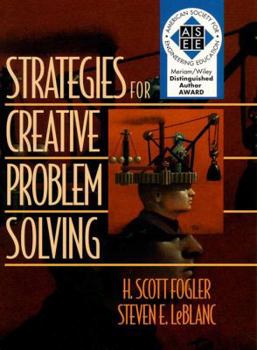Strategies for Creative Problem-Solving
Select Format
Select Condition 
Book Overview
A Tested, Proven Approach to Problem Solving-Updated with New Material and Current, Real-Life Examples Strategies for Creative Problem Solving, Third Edition, will help you hone your creative skills... This description may be from another edition of this product.
Format:Paperback
Language:English
ISBN:0131793187
ISBN13:9780131793187
Release Date:January 1994
Publisher:Prentice Hall
Length:224 Pages
Weight:0.75 lbs.
Dimensions:0.5" x 7.0" x 9.2"
Related Subjects
Behavioral Sciences Business Business & Finance Business & Investing Cognitive Cognitive Psychology Creativity & Genius Decision-Making & Problem Solving Education Engineering Health, Fitness & Dieting Health, Fitness & Dieting Industrial, Manufacturing & Operational Systems Instruction Methods Management & Leadership Pedagogy Psychology Psychology & Counseling Schools & Teaching Science & Math Skills Social Sciences Technology TextbooksCustomer Reviews
5 ratings
textbook
Published by Thriftbooks.com User , 15 years ago
I have enjoyed this book as it is a refresher for me in process improvement models. It is an easy book to read and understand.
Good book
Published by Thriftbooks.com User , 17 years ago
I used either this book or a similar one for my freshman engineering class. The reading and technical difficulty was appropriate for me in that class. Having worked at TRW, a little at GM, and now at Intel, I believe the concepts taught in this book are quite useful, and are practiced often by engineers at "engineering" companies. The problem is this book is usually read by students in their 1st year, then for the following 2 - 3 years of undergraduate schooling, students essentially sit in lecture classes learning concepts of science and technology. Come senior year, students are then expected to implement the lessons from this book as part of doing their capstone project, as if they even remember this book. Written by two engineering professors as a book for beginning engineering students, the problem solving concepts contained in this book are appropriate for anyone working in any field; not just engineering. The problem is it does not introduce students to the reality of life as a working engineer and does not help students choose which field of engineering they like to join. The question begs then as to what is the reality of life as an engineer... Excluding engineering professors, here is what I picture as the realities of being an engineer: 1) Technology constantly changes. Part of being an engineer is always deciding which changes to adopt and which to ignore. For example, at my biweekly group meeting in Intel, our manager shows us new automation software that we as a group must decide whether or not we want to adopt. We don't write these software, but we have to decide whether or not we want to use them. 2) Our skills are not needed. Doctors will always be needed, because people always get sick or hurt. Teachers will always be needed, because people always need to be taught stuff. But as engineers, many of the services and expertise we offer society can be done without. If the price of gasoline keeps going up, a lot of engineers who specialize on combustion engines are going to find themselves obsolete. Likewise, the rank of analog engineers working at Motorola have dwindled over the past decade. Therefore, part of being an engineer is having to constantly learn new skills. 3) We are very replaceable. For example, a family physician obtains and sustains his business by spending quality time with each and every of her patients. Very few people, once they find a family physician they like, will switch to another one. The same concept applies to dentists, car mechanics, hairdressers, tailors, vets, babysitters, home repairmen, insurance agents, etc... But engineers by and large work on producing a physical item; i.e. a computer, a car, a knee implant, a radio, etc... Outside of bridges, airplanes, power plants, etc... the final purchaser of our product will never come into contact with any of the engineers who helped designed or produced it. Therefore, price becomes more important in the purchasing of engine
Lecturer and Engineer
Published by Thriftbooks.com User , 19 years ago
I would highly recommend any engineering student to read this book. It is worthy to buy and keep it on your library. This will be one of many most useful books you have ever considered in your engineering career.
Fantastic Book: Not For Cry Babies
Published by Thriftbooks.com User , 20 years ago
This is mainly a to stress that problems can be solved with an open minded approach such as the authors recommend. Unlike the cry baby whose essentially useless review shows that he has not and never will solve any real world problems. Probably a disgruntled ex student who got a D-.
Well organized, and entertaining intro to problem solving
Published by Thriftbooks.com User , 24 years ago
This is a systematic and well organized introduction. I used it with managers and students not just engineers. What was important was not just to follow an algorithmic approach but to imbue a way of thinking. It simply is not true that everyone has formed the discipline to use their mind following these or similar heuristics. We may stumble on them naturally, I agree. But for many people this is a useful revelation. In addition to the book, they have produced software to engage you in learning the problem strategies. Compared to many other books on the subject, this book has enough real world examples and strategies that it is not just pop psychology or wishful thinking or one more brainstrom with web-like diagrams.




